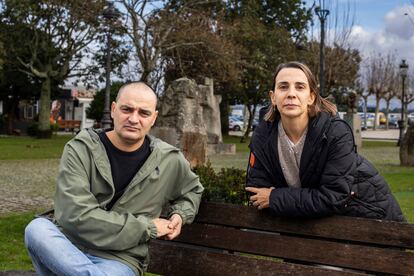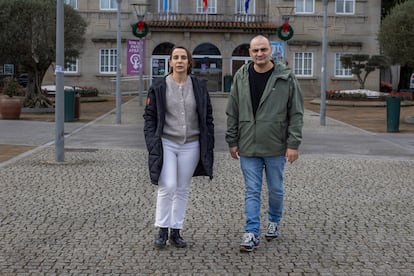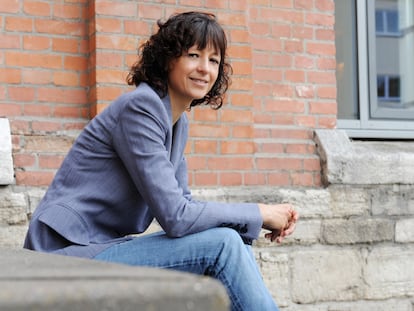A stem cell heart model solves the enigma of an inherited disease within a family
Spanish researchers discover an individual genetic variant that explains why a hereditary heart disease manifests very differently in two siblings

In their genes, both Olalla Radío and her brother Esteban carry traces of the same disease: hypertrophic cardiomyopathy, the most common hereditary heart condition. But while they have the same disease, it presents very differently in the two siblings: Olalla’s disease remains invisible and asymptomatic, while Esteban’s manifests in the most severe and incapacitating form.
Now, science has shown why the disease presents differently in the two siblings. Thanks to experiments using a heart model made with stem cells from the siblings, researchers at the Bellvitge Biomedical Research Institute (Idibell) and the Familial Heart Disease Unit at the A Coruña Hospital (CHUAC) in Spain have discovered that an additional genetic variation in Esteban’s case causes his disease to be expressed more severely.
The Spanish siblings’ hypertrophic cardiomyopathy came to light when Esteban, at just 15 years of age, began to feel unwell. An electrocardiogram revealed that “there was something wrong,” he recounts. Subsequent tests showed that he did indeed suffer from the disease, which involves a thickening of the muscle that surrounds the heart (myocardium) and can make it difficult for blood to leave the organ. The family also underwent genetic testing, and both his sister Olalla and his father had the same diagnosis. Only their older brother escaped the hereditary disease entirely.
Hypertrophic cardiomyopathy affects one in 500 people and is very complex; it has different manifestations and many associated genetic variants. “There are patients who may be asymptomatic, while others may develop obstructive hypertrophic cardiomyopathy: thickness is increased and the place where blood leaves the heart is narrowed. The person experiences fatigue, chest pain or syncope [fainting]. And it is the most common cause of sudden death in athletes,” says Roberto Barriales, the coordinator of the CHUAC Family Heart Disease Unit and the Radío siblings’ physician.
Now 41, Esteban says that it was not until well into his twenties that he began to experience the most serious symptoms and that they have become more serious over the years. “I felt fatigue, I was getting tired, dizzy... But I didn’t start getting arrhythmias until seven or eight years ago; I led a more or less normal life [before that]. Between 2014 and 2019 I had a hard time because [my] heart is aging, and I began to notice palpitations and discomfort,” he notes.

Barriales explains that hypertrophic cardiomyopathy is a familial disease, and each patient has a 50% chance of transmitting to their offspring: “There are different pathogenic genetic variants, different genes involved. In 60% of cases, we can identify the genetic variant of the disease, which is a very good thing, since it helps in the prognosis and in monitoring the family.” The physician admits that it can also be the case “that the variant has been inherited and the disease will not develop. You can be a healthy carrier of a variant, but you can pass it on to your descendants. Why? Intrafamilial variability is something that is being studied, and there may be another variant in another gene that makes you modulate the disease. You may need more than one pathogenic variant.”
Doctors always noted the very different manifestations of the disease in this family. “Esteban had a severe phenotype and his sister and father had a very mild form. Esteban had a lot of hypertrophy, malignant ventricular arrhythmias, fatigue,” Barriales notes. In fact, he had to be fitted with an implantable cardioverter defibrillator (ICD) to restore his normal heart rhythm when he experienced arrhythmia. “The ICD saved my brother’s life. He didn’t know about it, he thought it was syncope, but it wasn’t. He has lived for six years thanks to the ICD,” says Olalla. Now 43 years old, her disease still hasn’t manifested. “I haven’t had any symptoms. But since my children had a 50% chance of having the disease, I did the preimplantation genetic diagnosis and genetically my daughter is free of it now,” she says with relief. Esteban’s daughter does not have the disease either.
Searching for individual genetic variants
Barriales recalls when Dr. Angel Raya, the coordinator of the Regenerative Medicine Program at Idibell, contacted him looking for patients with the same characteristics as the siblings, that is, carriers of the same mutation that causes the disease but with different manifestations of the ailment. The scientists wanted to find the individual genetic variants responsible for each of the pathological manifestations. And the siblings threw themselves headlong into the study: “We always volunteer for everything. I did it out of blind trust in the whole [Barriales] team. Thanks to them, we have a serious disease under control,” says Olalla.
The idea was to use a heart model, with stem cells from Esteban and Olalla, to explain the symptomatic differences between the siblings. “We had been generating models of genetically based diseases for some time using induced pluripotent cells, similar to those of patients. With organs like the brain or the heart, you can’t take out a piece and study it, so we used this trick of creating stem cells and seeing how they work,” explains Raya, the director of this project and a researcher at the Catalan Institute for Research and Advanced Studies.
Each sibling underwent a biopsy of the skin tissue and the cells obtained in the procedure were converted into stem cells, which can differentiate into any other type of cell. “Using skin cells, which are taken from the buttocks, they were dedifferentiated into stem cells and then differentiated again into cardiomyocytes, which are heart cells,” Barriales explains. Using gene-editing techniques like the CRISPR tool, the researchers tried to identify each sibling’s genetic variants and then removed them and put them into these heart models to see which ones cause a given symptom.
With the specific variant that is only present in Esteban’s cells, the scientists saw “that the cardiomyocytes contracted abnormally, they were hyperexcitable,” says Raya. In subsequent tests with heart models, the researchers found that the brother’s more severe symptoms could indeed be explained by the presence of this additional mutation. Led by Idibell and with the participation of CHUAC, Josep Trueta de Girona Hospital and the National Center for Cardiovascular Research, the study has been published in the Circulation Research journal.
A much more accurate prognosis
“The Raya study has allowed us to answer the question of why the [disease] presents differently in this family. And that can also be done in other families to see which other variants of uncertain significance can modify the phenotype of the disease in a more severe one,” reflects Barriales. The study sheds light on the prognosis of the disease and also opens the door for identifying potential therapeutic targets to find new drugs, the cardiologist adds. “We know that Olalla’s disease will not present severely because she doesn’t have the other variant, and we also know now that her prognosis will be good. In Esteban’s case, we do not have a genetic treatment to offer him, but he is [participating] in a trial for non-obstructive hypertrophic cardiomyopathy, using a drug that tries to take a little strength away from the heart so that it can function better, because excess strength does not allow the organ to relax well.”
Raya argues that, in effect, his studies open the door for therapies, but qualifies that this step will happen in the future. “We are left with diagnosis and prognosis,” he says, but he does not rule out the possibility of studying “a collection of heart models with different mutations and testing the new drugs that are coming out.”
This is not the first time that science has modeled genetic diseases to solve some of their enigmas. It has already been done with Fanconi anemia and Parkinson’s disease, the researcher explains. And although it is a promising strategy, he concedes that the approach also has its limitations. “The main drawback is that a model is a simplified version of what you are modeling. If you need a lot of complexity, it’s very difficult to model it. And there are also diseases that require very mature cells and the cells we make are immature,” says Raya.
Sign up for our weekly newsletter to get more English-language news coverage from EL PAÍS USA Edition
Tu suscripción se está usando en otro dispositivo
¿Quieres añadir otro usuario a tu suscripción?
Si continúas leyendo en este dispositivo, no se podrá leer en el otro.
FlechaTu suscripción se está usando en otro dispositivo y solo puedes acceder a EL PAÍS desde un dispositivo a la vez.
Si quieres compartir tu cuenta, cambia tu suscripción a la modalidad Premium, así podrás añadir otro usuario. Cada uno accederá con su propia cuenta de email, lo que os permitirá personalizar vuestra experiencia en EL PAÍS.
¿Tienes una suscripción de empresa? Accede aquí para contratar más cuentas.
En el caso de no saber quién está usando tu cuenta, te recomendamos cambiar tu contraseña aquí.
Si decides continuar compartiendo tu cuenta, este mensaje se mostrará en tu dispositivo y en el de la otra persona que está usando tu cuenta de forma indefinida, afectando a tu experiencia de lectura. Puedes consultar aquí los términos y condiciones de la suscripción digital.
More information
Archived In
Últimas noticias
Aquilino Gonell, former Capitol sergeant: ‘If it hadn’t been for the police, the US would be a dictatorship’
A hybrid building: Soccer pitch, housing, and a shopping mall
Europe urges Trump to respect Greenland following annexation threats
Science seeks keys to human longevity in the genetic mixing of Brazilian supercentenarians
Most viewed
- Alain Aspect, Nobel laureate in physics: ‘Einstein was so smart that he would have had to recognize quantum entanglement’
- Mexico’s missing people crisis casts a shadow over World Cup venue
- Why oil has been at the center of Venezuela-US conflicts for decades
- Alvin Hellerstein, a 92-year-old judge appointed by Bill Clinton, to preside over Maduro’s trial in New York
- Cuba confirms death of 32 of its citizens in the US attack against Venezuela











































